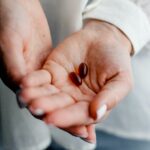 Mastocytosis (M) represents a heterogeneous disease characterized by increased accumulation and clonal proliferation of mast cells in the skin and/or different organs. Broadly, M is classified into two categories: cutaneous mastocytosis (CM) and systemic mastocytosis (SM). In children, CM is the most frequent form, but the lesions differ in clinical forms. We present a clinical case of a boy of 1 year and 4 months, who at 4 months of age after a severe allergic reaction was diagnosed with a solitary mastocytoma, confirmed by skin biopsy. Mastocytoma was noticed by the parents 4 days after birth. The patient has elevated levels of histamine and serum tryptase. Genetic marker KIT D816V in the blood is negative.Children often suffer from mast cell mediator-related symptoms. Severe hypersensitivity reactions can also occur, mostly in patients with extensive skin lesions and blistering. The evaluation of the pediatric patient with CM usually comprises laboratory exams, a skin biopsy and a complete clinical evaluation. It is also defining to distinguish between CM and other diseases with cutaneous involvement. The management of CM in childhood is mainly based on strict avoidance of triggers. The available cures are oral H1 and/or H2 antihistamines, oral cromolyn sodium, photochemotherapy, potent dermatocorticoid, calcineurin inhibitors and equipment of patients and their families with adrenaline autoinjector for use in severe anaphylactic reactions. In children, the prognosis of CM is excellent and in the majority of the cases the skin lesions regress spontaneously around puberty. Тhe heterogeneous symptoms of the various subvariants of mastocytosis require multidisciplinary cooperation and comprehensive care. Read the full article here.
Mastocytosis (M) represents a heterogeneous disease characterized by increased accumulation and clonal proliferation of mast cells in the skin and/or different organs. Broadly, M is classified into two categories: cutaneous mastocytosis (CM) and systemic mastocytosis (SM). In children, CM is the most frequent form, but the lesions differ in clinical forms. We present a clinical case of a boy of 1 year and 4 months, who at 4 months of age after a severe allergic reaction was diagnosed with a solitary mastocytoma, confirmed by skin biopsy. Mastocytoma was noticed by the parents 4 days after birth. The patient has elevated levels of histamine and serum tryptase. Genetic marker KIT D816V in the blood is negative.Children often suffer from mast cell mediator-related symptoms. Severe hypersensitivity reactions can also occur, mostly in patients with extensive skin lesions and blistering. The evaluation of the pediatric patient with CM usually comprises laboratory exams, a skin biopsy and a complete clinical evaluation. It is also defining to distinguish between CM and other diseases with cutaneous involvement. The management of CM in childhood is mainly based on strict avoidance of triggers. The available cures are oral H1 and/or H2 antihistamines, oral cromolyn sodium, photochemotherapy, potent dermatocorticoid, calcineurin inhibitors and equipment of patients and their families with adrenaline autoinjector for use in severe anaphylactic reactions. In children, the prognosis of CM is excellent and in the majority of the cases the skin lesions regress spontaneously around puberty. Тhe heterogeneous symptoms of the various subvariants of mastocytosis require multidisciplinary cooperation and comprehensive care. Read the full article here.
informer
 An important breakthrough in the negotiations between the European Parliament and the EU Council regarding the scope and content of the future EU Health Technology Assessment (HTA) regulations was announced on 22nd June 2021. This agreement was anticipated as an important step towards achieving numerous goals, including improved access to innovative therapies for EU patients and more efficient use of the available health resources in the Member States. What exactly happened on that date and what should we expect to follow? Read the full article here.
An important breakthrough in the negotiations between the European Parliament and the EU Council regarding the scope and content of the future EU Health Technology Assessment (HTA) regulations was announced on 22nd June 2021. This agreement was anticipated as an important step towards achieving numerous goals, including improved access to innovative therapies for EU patients and more efficient use of the available health resources in the Member States. What exactly happened on that date and what should we expect to follow? Read the full article here.
Celiac crisis – a clinical case of acute onset of celiac disease in a 39-year-old woman
 Celiac disease is an autoimmune systemic disorder, predominantly affecting the small intestine resulting in chronic inflammation. It is associated with gluten ingestion – a protein ingredient of wheat, rye, barley and oats. Susceptible and genetically predisposed individuals develop the disease in childhood or in adolescence. Common symptoms include diarrhea and signs of malabsorption, but the disease could occur with atypical manifestations such as anemia, dermatitis, osteopenia, infertility, nervous system involvement, behavioral disorders.Rare cases of acute onset of the disease in adulthood are published in the literature – celiac crisis. In this case typical are metabolic dysregulation, dyselectrolytemia, neurological disorders and higher mortality. We present a clinical case of a 39-year-old female patient with acute onset of the disease, anemia, diarrhea, electrolyte disorders, tetany, limb paresis. Serological, endoscopic and histologic findings confirm the diagnosis celiac disease. Gluten-free diet was then introduced, which led to clinical recovery. Read the full article here.
Celiac disease is an autoimmune systemic disorder, predominantly affecting the small intestine resulting in chronic inflammation. It is associated with gluten ingestion – a protein ingredient of wheat, rye, barley and oats. Susceptible and genetically predisposed individuals develop the disease in childhood or in adolescence. Common symptoms include diarrhea and signs of malabsorption, but the disease could occur with atypical manifestations such as anemia, dermatitis, osteopenia, infertility, nervous system involvement, behavioral disorders.Rare cases of acute onset of the disease in adulthood are published in the literature – celiac crisis. In this case typical are metabolic dysregulation, dyselectrolytemia, neurological disorders and higher mortality. We present a clinical case of a 39-year-old female patient with acute onset of the disease, anemia, diarrhea, electrolyte disorders, tetany, limb paresis. Serological, endoscopic and histologic findings confirm the diagnosis celiac disease. Gluten-free diet was then introduced, which led to clinical recovery. Read the full article here.
 On 10-11 September 2021, for 12th consecutive year, the Institute for Rare Diseases has organised the the National Conference for Rare Diseases and Orphan Drugs. The conference is an annual forum that brings together all stakeholders – health care professionals, patients, medical students, health authorities and industry. This year, 46 speakers took part in the Scientific Program and presented current topics related to innovations in the diagnosis, treatment and follow-up care for patients with rare diseases, the development of European reference networks and all latest news related to access to innovation. The Poster session included 29 scientific posters on various topics related to rare diseases. More than 80 interactive materials and videos accessible 24/7 are presented at the Virtual Booths of the Institute for Rare Diseases, the National Alliance of People with Rare Diseases and our industry partners.
On 10-11 September 2021, for 12th consecutive year, the Institute for Rare Diseases has organised the the National Conference for Rare Diseases and Orphan Drugs. The conference is an annual forum that brings together all stakeholders – health care professionals, patients, medical students, health authorities and industry. This year, 46 speakers took part in the Scientific Program and presented current topics related to innovations in the diagnosis, treatment and follow-up care for patients with rare diseases, the development of European reference networks and all latest news related to access to innovation. The Poster session included 29 scientific posters on various topics related to rare diseases. More than 80 interactive materials and videos accessible 24/7 are presented at the Virtual Booths of the Institute for Rare Diseases, the National Alliance of People with Rare Diseases and our industry partners.
The registered conference participants will have the opportunity, within the month of September, to view all recordings of the lectures, Scientific Posters and to visit the digital materials available at the Virtual Booths in the Virtual Congress Venue.
(Български) Г-жа Ваня Добрева – лектор на XII Национална конференция за редки болести и лекарства сираци
Sorry, this entry is only available in Български.
(Български) Доц. Ася Консулова – лектор на XII Национална конференция за редки болести и лекарства сираци
Sorry, this entry is only available in Български.
(Български) Проф. Емил Паскалев – лектор на XII Национална конференция за редки болести и лекарства сираци
Sorry, this entry is only available in Български.
(Български) Проф. Нина Гочева – лектор на XII Национална конференция за редки болести и лекарства сираци
Sorry, this entry is only available in Български.
(Български) Доц. Гергана Петрова – лектор на XII Национална конференция за редки болести и лекарства сираци
Sorry, this entry is only available in Български.
For more information about this disease, please visit following websites: Orphanet and NIH Office of Rare Diseases Research.
